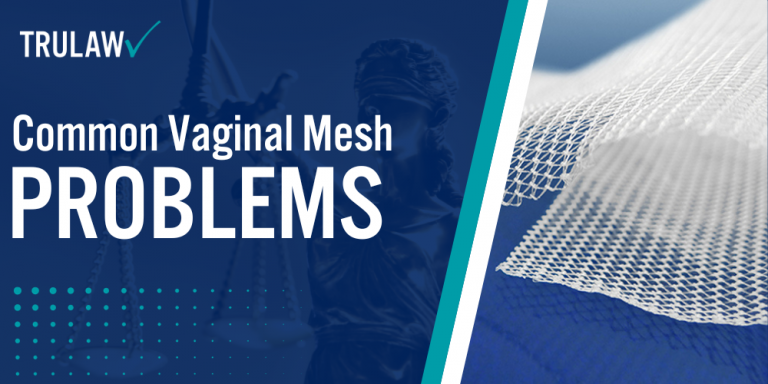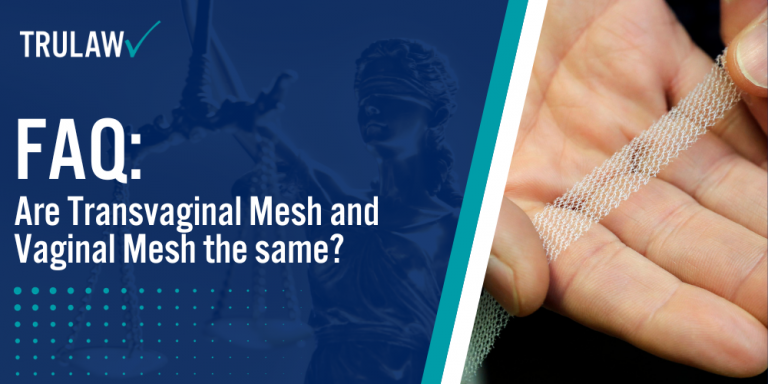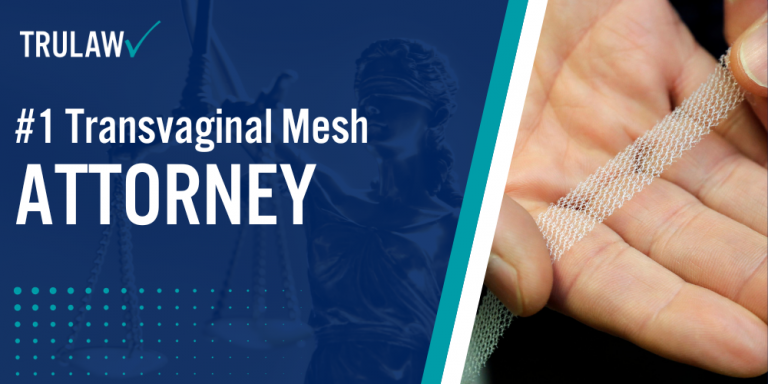What Are The Challenges In Transvaginal Mesh Litigation?
- Last Updated: July 9th, 2024

Attorney Jessie Paluch, founder of TruLaw, has over 25 years of experience as a personal injury and mass tort attorney, and previously worked as an international tax attorney at Deloitte. Jessie collaborates with attorneys nationwide — enabling her to share reliable, up-to-date legal information with our readers.
Legally Reviewed
This article has been written and reviewed for legal accuracy and clarity by the team of writers and legal experts at TruLaw and is as accurate as possible. This content should not be taken as legal advice from an attorney. If you would like to learn more about our owner and experienced injury lawyer, Jessie Paluch, you can do so here.
Fact-Checked
TruLaw does everything possible to make sure the information in this article is up to date and accurate. If you need specific legal advice about your case, contact us by using the chat on the bottom of this page. This article should not be taken as advice from an attorney.
Key takeaways:
- Surgeons often defend mesh usage by demonstrating its necessity in treating conditions like stress urinary incontinence and improving patients' quality of life. This highlights the importance of proper surgical management as a key defense strategy.
- Defense teams focus on showcasing the benefits of using mesh for pelvic organ prolapse repair while managing potential risks such as exposure and pain. This emphasizes the critical evaluation of the benefits versus the risks associated with mesh usage.
- Defense strategies underscore the medical necessity and effectiveness of synthetic mesh in treating prolapsed organs, emphasizing improved support for weakened tissue and positive patient outcomes. This highlights the importance of emphasizing previous successful cases and medical evidence to support the use of mesh in litigation defense.
What Are the Challenges in Transvaginal Mesh Litigation?
On this page, we’ll discuss an overview of the challenges in transvaginal mesh litigation, potential transvaginal mesh settlement amounts, how to file a claim in transvaginal mesh litigation, and much more.
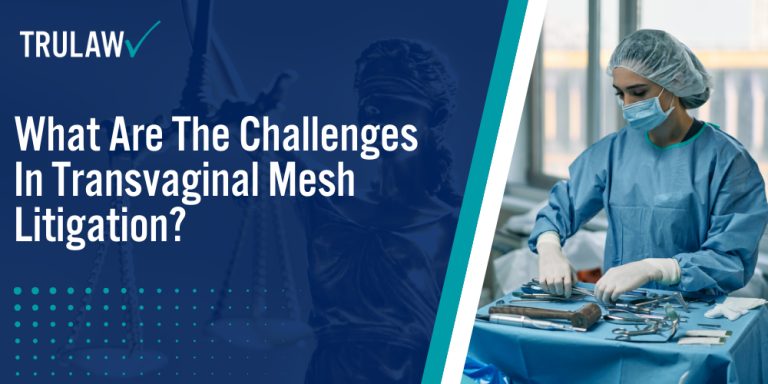
Intro to Transvaginal Mesh Litigation Challenges
The transvaginal mesh litigation primarily stems from complications associated with surgical mesh procedures to treat pelvic organ prolapse (POP) and stress urinary incontinence (SUI).
Common challenges of transvaginal mesh litigation include:
- Proving Causation and Injury: Plaintiffs must link their injuries directly to the transvaginal mesh, often requiring expert testimony amidst diverse medical backgrounds.
- Assessing Damages: Calculating fair compensation for enduring pain, medical costs, and lost wages is difficult, especially with persistent injuries.
- Vaginal Mesh Multidistrict Litigation (MDL): Although the transvaginal mesh MDL is mostly resolved, women with mesh complications can still pursue individual lawsuits.
If you or a loved one has experienced injuries related to vaginal mesh surgery, you may be able to seek compensation.
Contact TruLaw using the chat on this page to file a transvaginal mesh lawsuit today.
Table of Contents
Transvaginal Mesh Litigation: FDA Recommendations
The FDA has issued various recommendations and warnings with regard to transvaginal mesh devices as a response to the complications associated with them.
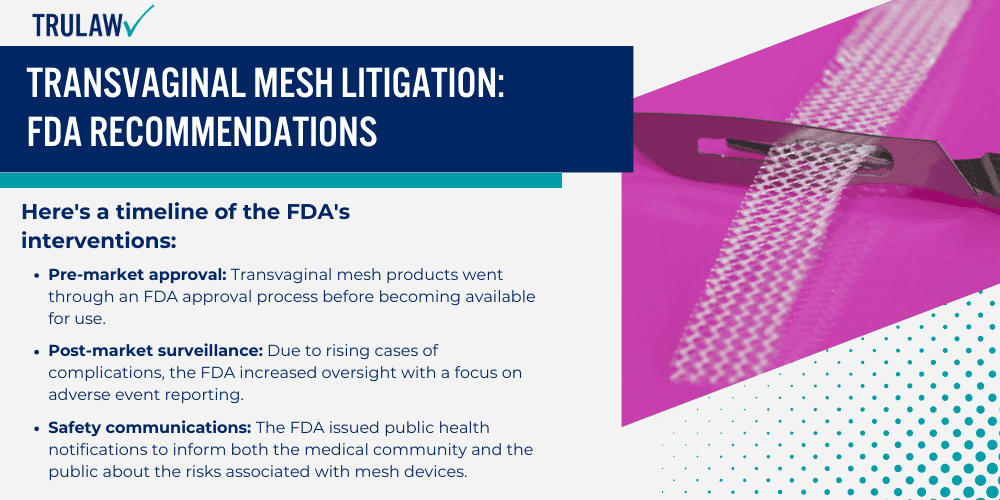
This section explores the nuances of FDA actions and the medical context of these devices.
FDA Approvals and Warnings
The Food and Drug Administration (FDA) regulates medical devices, including transvaginal mesh devices.
In light of safety concerns, the FDA has been actively involved in the scrutiny of these devices over the past years.
Here’s a timeline of the FDA’s interventions:
- Pre-market approval: Transvaginal mesh products went through an FDA approval process before becoming available for use.
- Post-market surveillance: Due to rising cases of complications, the FDA increased oversight with a focus on adverse event reporting.
- Safety communications: The FDA issued public health notifications to inform both the medical community and the public about the risks associated with mesh devices.
- Mandatory reporting: The FDA emphasized the need for mandatory reporting of mesh-related complications by manufacturers.
- Litigation response: In response to litigation, the FDA has taken steps to assess the legal framework governing the use of transvaginal mesh.
- Recommendations: Based on its findings, the FDA has released recommendations aimed at protecting patient health and safety.
Medical Uses
Transvaginal mesh devices have been utilized for various medical purposes, each backed by clinical judgment and patients’ needs.
Below are the primary medical applications of these devices:
- Pelvic organ prolapse (POP): Mesh devices are commonly used to provide support for weakened or damaged tissue in pelvic organ prolapse.
- Stress urinary incontinence (SUI): Another use of mesh is for the treatment of stress urinary incontinence, where stress on the bladder leads to unintentional urine leakage.
- Surgical repair: Mesh is employed to reinforce the vaginal wall during surgery for pelvic organ prolapse repair.
- Strengthening support: The mesh can also serve as a long-term solution to strengthen the pelvic floor when non-surgical options are inadequate.
The FDA’s recommendations and regulatory actions regarding transvaginal mesh devices are significant because they impact legal proceedings and clinical practices involving these medical products.
Transvaginal Mesh Litigation Legal Framework
Over the years, transvaginal mesh litigation has developed a complex legal framework, particularly within the federal court system.
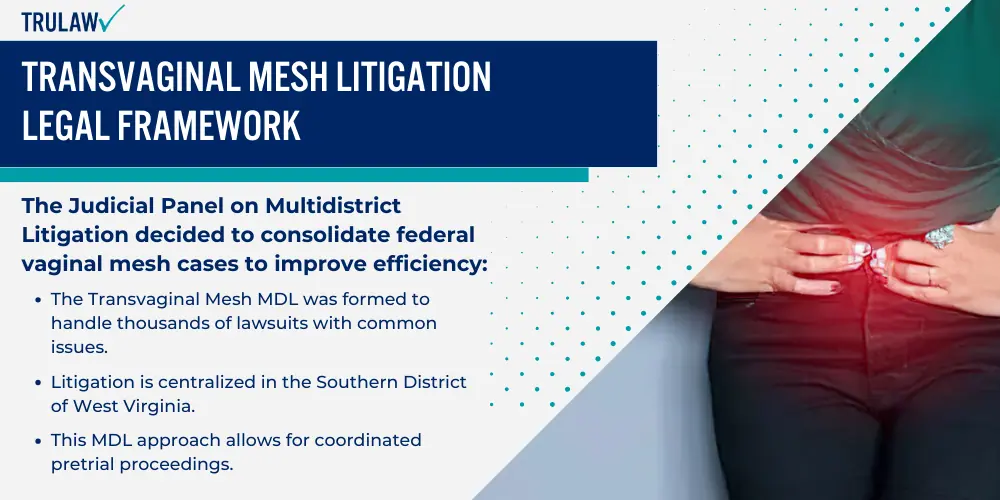
This legal structure is critical in managing the numerous lawsuits filed against manufacturers of pelvic mesh products.
Multidistrict Litigation
Multidistrict litigation (MDL) plays a pivotal role in the legal proceedings for transvaginal mesh lawsuits.
The Judicial Panel on Multidistrict Litigation decided to consolidate federal vaginal mesh cases to improve efficiency:
- The Transvaginal Mesh MDL was formed to handle thousands of lawsuits with common issues.
- Litigation is centralized in the Southern District of West Virginia.
- This MDL approach allows for coordinated pretrial proceedings.
- Streamlined discovery processes prevent duplicate efforts.
- Bellwether trials are conducted to guide potential vaginal mesh settlement discussions.
- Allows plaintiffs to pool resources and streamline legal strategies.
The benefits of an MDL are demonstrated in how transvaginal mesh litigation is conducted, emphasizing the MDL’s efficiency and organization in handling complex cases.
Key Legal Decisions
Significant legal precedents in transvaginal mesh litigation have emerged from key decisions made by the District of West Virginia, with bellwether trials yielding substantial verdicts that inform ongoing negotiations and settlements.
These landmark rulings not only establish liability for pelvic mesh products but also profoundly influence the trajectory of future litigation, shaping the landscape of earlier vaginal mesh lawsuits and guiding settlement negotiations.
Several key legal decisions have had a significant impact on the fray of transvaginal mesh litigation:
- The District of West Virginia has presided over important bellwether trials.
- These trials have resulted in substantial verdicts, influencing upcoming cases.
- They have established legal precedent on the liability of pelvic mesh products.
- The outcomes of these crucial trials have informed negotiations and settlements.
Each decision from the District of West Virginia furthers the legal contours shaping the landscape of earlier vaginal mesh lawsuits.
These landmark rulings carry powerful implications for future litigation and settlement negotiations.
Major Cases and Settlements in the Transvaginal Mesh Litigation
Transvaginal mesh litigation has seen substantial activity with various cases leading to significant verdicts and settlement offers.
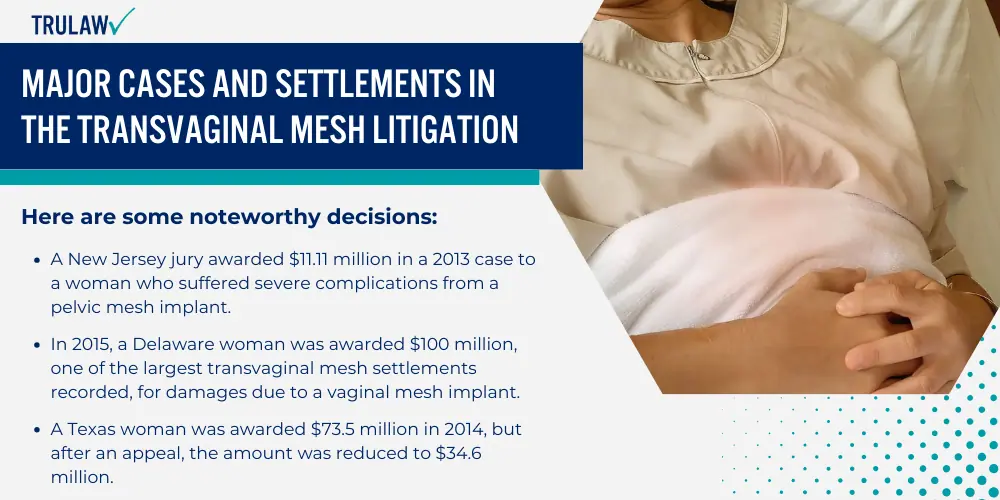
Plaintiffs have been awarded large amounts in individual lawsuits and through class action settlements.
Significant Verdicts
Several major mesh verdicts have been awarded by juries, reflecting the severity of the complications arising from the use of transvaginal mesh.
Here are some noteworthy decisions:
- A New Jersey jury awarded $11.11 million in a 2013 case to a woman who suffered severe complications from a pelvic mesh implant.
- In 2015, a Delaware woman was awarded $100 million, one of the largest transvaginal mesh settlements recorded, for damages due to a vaginal mesh implant.
- A Texas woman was awarded $73.5 million in 2014, but after an appeal, the amount was reduced to $34.6 million.
- Vaginal mesh lawsuit updates frequently reveal new verdicts, such as a $41 million verdict handed by a Philadelphia jury in 2019.
Landmark Settlement Offers
Manufacturers of transvaginal mesh have made substantial landmark settlement offers to resolve cases en masse.
Below are some pivotal settlement offers:
- Endo International Plc agreed to pay $830 million in 2014 to settle approximately 22,000 lawsuits.
- Johnson & Johnson’s Ethicon unit has been involved in ongoing settlements, totaling in the hundreds of millions.
- C.R. Bard resolved a number of cases, with some settlements reported reaching $200 million.
- In 2017, Boston Scientific agreed to pay $189 million to resolve 3,000 cases.
The compensation amounts from these settlements have provided some measure of relief for the plaintiffs, reflecting the industry’s acknowledgment of the serious repercussions of mesh implants.
Manufacturers and Products Named In Transvaginal Mesh Litigation
Transvaginal mesh litigation has involved many cases in which several manufacturers have been identified for their involvement in producing and distributing these medical products.
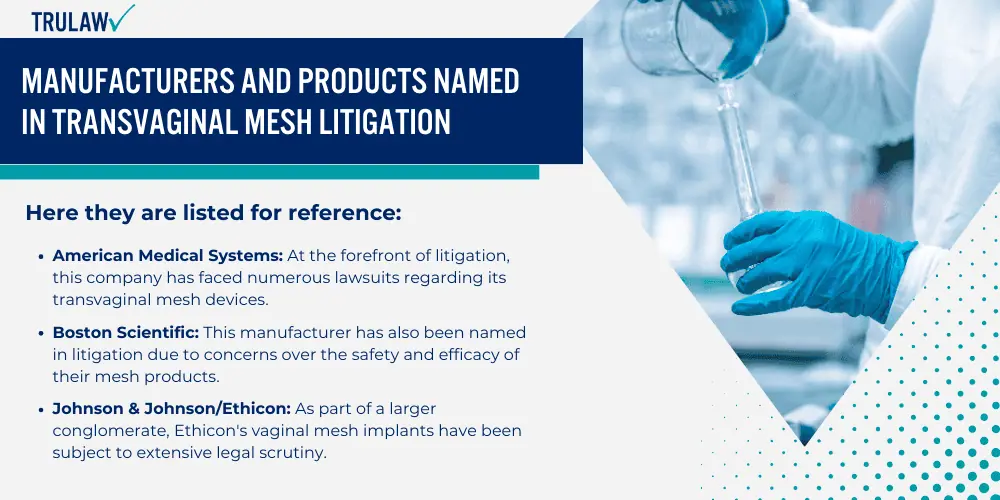
Notable Companies
Numerous vaginal mesh makers have been embroiled in litigation due to complications arising from their products.
Here they are listed for reference:
- American Medical Systems: At the forefront of litigation, this company has faced numerous lawsuits regarding its transvaginal mesh devices.
- Boston Scientific: This manufacturer has also been named in litigation due to concerns over the safety and efficacy of their mesh products.
- Johnson & Johnson/Ethicon: As part of a larger conglomerate, Ethicon’s vaginal mesh implants have been subject to extensive legal scrutiny.
- C.R. Bard: This corporation has encountered legal challenges over their mesh devices, with numerous claims filed against them.
- Coloplast Corp.: Another key player, Coloplast has been part of the vaginal mesh litigation, with patients reporting adverse effects following their mesh surgeries.
In each case, the manufacturers have been challenged to defend the safety profiles of their specific vaginal mesh products and their long-term impact on patient health.
The litigation’s overall focus has revolved around the adequacy of warnings provided to patients and healthcare providers and the thoroughness of clinical testing prior to bringing these products to market.
Qualifying for the Transvaginal Mesh Litigation
To qualify for transvaginal mesh litigation, claimants must demonstrate a direct link between their medical complications and the mesh implant.
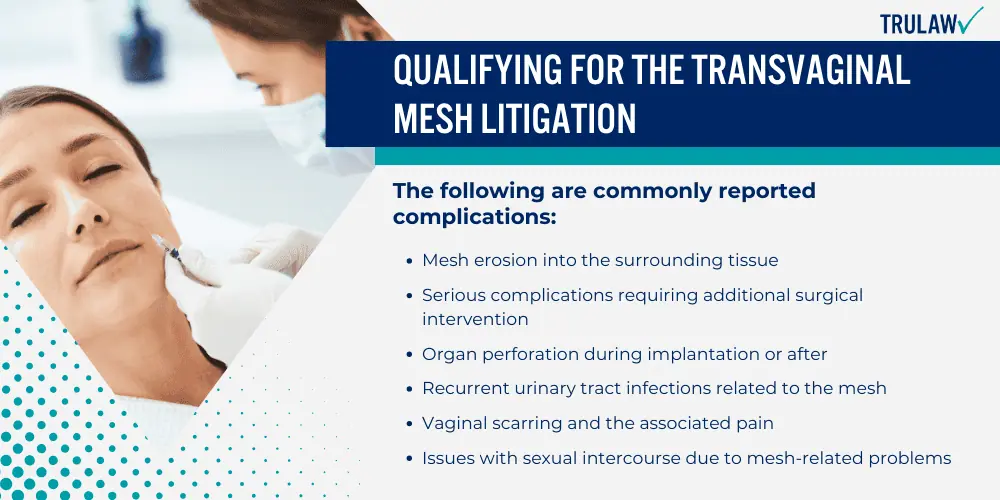
Criteria for eligibility revolve around the severity and type of mesh-related complications experienced post-surgery.
Reported Adverse Effects
Patients who have experienced adverse effects following transvaginal mesh surgery may be eligible for litigation.
These effects, often detailed in medical reports, establish the grounds for claims.
The following are commonly reported complications:
- Mesh erosion into the surrounding tissue
- Serious complications requiring additional surgical intervention
- Organ perforation during implantation or after
- Recurrent urinary tract infections related to the mesh
- Vaginal scarring and the associated pain
- Issues with sexual intercourse due to mesh-related problems
- Severe complications that impact quality of life
Long-Term Health Considerations
For long-term health implications of transvaginal mesh implants, a chronological analysis of medical conditions post-surgery is necessary.
Affected individuals typically present a history of chronic symptoms, which may include:
- Painful sexual intercourse recurring over time
- Chronic vaginal scarring, leading to discomfort and reduced elasticity
- Continued challenges with urinary functions, such as recurrent infections
- Persistent pelvic or vaginal pain unalleviated by conventional treatments
Patients presenting these long-term health issues may form the basis for extended litigation, as they highlight the lasting effects of the mesh implant.
Transvaginal Mesh Litigation Process
This section delves into the intricate steps involved with transvaginal mesh litigation, discussing how these legal proceedings unfold from initiation to the key factors considered in claims evaluation.
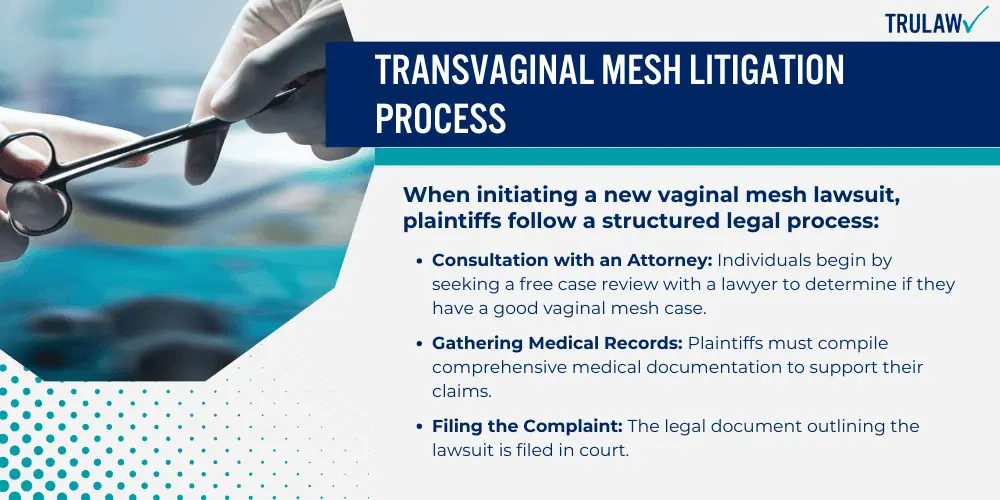
Filing a Lawsuit
To start a vaginal mesh lawsuit, you’ll need to consult with an attorney to assess your case.
When initiating a new vaginal mesh lawsuit, plaintiffs follow a structured legal process:
- Consultation with an Attorney: Individuals begin by seeking a free case review with a lawyer to determine if they have a good vaginal mesh case.
- Gathering Medical Records: Plaintiffs must compile comprehensive medical documentation to support their claims.
- Filing the Complaint: The legal document outlining the lawsuit is filed in court.
- Serving the Defendant: The company or parties being sued are formally notified of the allegations and the lawsuit.
What to Expect
Transvaginal mesh lawsuits typically follow a complex trajectory, involving phases such as discovery, where information is exchanged; pretrial motions that can influence the case’s course; settlement discussions; and, if necessary, a trial where a judge or jury renders a decision.
The trajectory of a transvaginal mesh lawsuit can be complex and multi-faceted:
- Discovery Phase: Both sides exchange information to understand the specifics of the case.
- Pretrial Motions: Before trial, various motions may be filed that can shape the outcome or the progression of the lawsuit.
- Settlement Discussions: Often, parties will engage in negotiations to reach a settlement before reaching trial.
- Trial: If a settlement is not reached, the case may go to trial where a judge or jury will render a decision.
Case Evaluation Criteria
Attorneys evaluate current vaginal mesh lawsuits based on injury severity, impact on quality of life, medical history relevance, and potential MDL inclusion.
Evaluations also consider adherence to FDA guidelines and manufacturer warnings.
Attorneys use specific criteria to evaluate the merits of current vaginal mesh lawsuits:
- Extent of Injuries: Severe complications or injuries bolster the plaintiff’s case.
- The Impact on Quality of Life: The degree to which the mesh has affected the individual’s daily living.
- Previous Medical History: Understanding the plaintiff’s medical background can be essential in establishing the mesh as the cause of complications.
- Panels on Multidistrict Litigation (MDL): Whether the case will be included in an MDL, which groups together similar cases for streamlined pre-trial proceedings.
The evaluation of vaginal mesh claims also considers the adherence to FDA guidelines and the presence of any warnings provided to patients by the manufacturers.
Patient Resources For The Transvaginal Mesh Litigation
Those affected by vaginal mesh complications have various resources available to assist in managing the litigation process, from support groups to legal assistance for potential compensation.
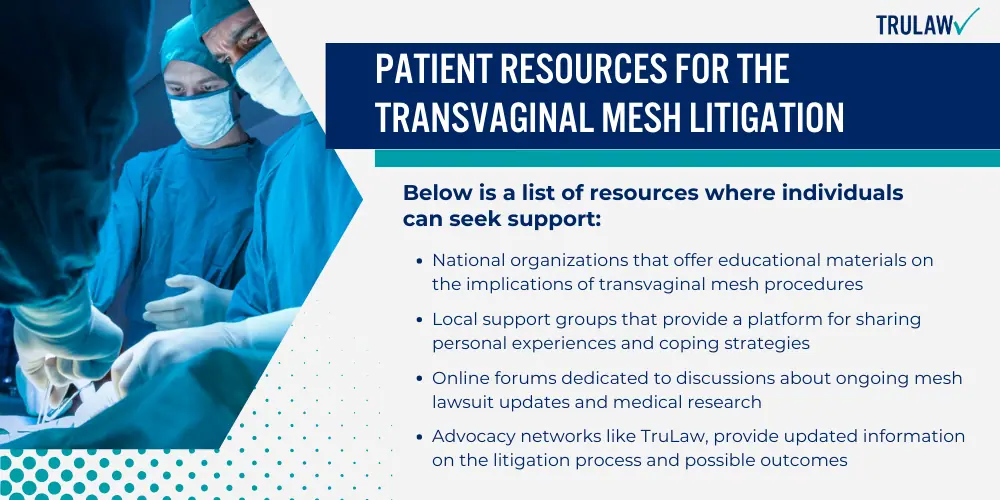
Support and Advocacy Groups
Individuals impacted by defective transvaginal mesh implants can turn to numerous support and advocacy groups that provide resources and communal assistance.
Below is a list of resources where individuals can seek support:
- National organizations that offer educational materials on the implications of transvaginal mesh procedures
- Local support groups that provide a platform for sharing personal experiences and coping strategies
- Online forums dedicated to discussions about ongoing mesh lawsuit updates and medical research
- Advocacy networks like TruLaw, provide updated information on the litigation process and possible outcomes
Seeking Legal Assistance
It’s crucial for individuals to find the right transvaginal mesh lawyer to navigate through the complexities of litigation.
The following steps outline how to secure legal representation:
- Research and identify experienced vaginal mesh lawyers with a proven track record in similar cases
- Schedule consultations with selected lawyers to discuss the specifics of your case, including any medical expenses incurred as a result of the mesh implant
- Confirm that the lawyer understands the latest mesh lawsuit updates and is well-versed in ongoing litigation trends
- Choose a vaginal mesh lawyer who clearly explains your rights and the potential for settlements and verdicts
Compensation and Claims
Pursuing claims for compensation involves understanding the types of financial restitution available.
Following are key forms of compensation individuals may be entitled to receive:
- Medical expenses related to transvaginal mesh complications, both past and future
- Lost wages or loss of earning capacity due to health issues stemming from the mesh implant
- Pain and suffering damages resulting from physical and emotional distress
- Punitive damages, if applicable, in cases of egregious negligence on the part of the mesh manufacturer
By leveraging the full spectrum of these resources, individuals engaged in transvaginal mesh litigation can better navigate the legal landscape.
Frequently Asked Questions
-
What are the common complications associated with transvaginal mesh implants?
Many individuals have reported complications following surgery with transvaginal mesh implants.
These complications often include mesh erosion, infections, bleeding, pain during intercourse, organ perforation, and urinary problems.
-
How do I file a claim for a transvaginal mesh lawsuit?
To initiate a lawsuit for complications associated with a transvaginal mesh procedure, individuals must first consult a legal professional specializing in such cases.
They will guide you through the process, which typically involves reviewing medical records, filing a complaint, and ensuring adherence to your state’s statute of limitations.
-
What is the statute of limitations for filing a bladder mesh lawsuit?
The statute of limitations for filing a bladder mesh lawsuit varies depending on the state where the implant surgery took place.
To avoid missing the deadline for legal action, verifying the specific timeframe applicable in your state is crucial as soon as any complications arise.
-
What are the latest updates on the bladder sling litigation?
Recent updates on bladder sling litigation reveal multiple manufacturers have faced lawsuits, with some opting for settlements.
FDA actions and changes in product labeling have also influenced the course of litigation. Here are the latest updates on transvaginal mesh litigation.
-
How can I find experienced attorneys for a bladder mesh lawsuit?
Finding experienced attorneys for a bladder mesh lawsuit requires researching legal professionals with a track record in medical device litigation.
It is recommended to consult with firms or lawyers that have successfully handled transvaginal mesh cases and deeply understand the associated medical and legal issues.
-
Have there been recent notable settlements in the vaginal mesh problems lawsuits?
Recently, there have been numerous settlements in vaginal mesh lawsuits against various manufacturers.
Each settlement varies in size based on the case’s particulars, with some leading to significant compensation for the claimants reflecting the severity of their injuries and the impact on their quality of life.

Experienced Attorney & Legal SaaS CEO
With over 25 years of legal experience, Jessie is an Illinois lawyer, a CPA, and a mother of three. She spent the first decade of her career working as an international tax attorney at Deloitte.
In 2009, Jessie co-founded her own law firm with her husband – which has scaled to over 30 employees since its conception.
In 2016, Jessie founded TruLaw, which allows her to collaborate with attorneys and legal experts across the United States on a daily basis. This hypervaluable network of experts is what enables her to share reliable legal information with her readers!
You can learn more about the Transvaginal Mesh Lawsuit by visiting any of our pages listed below:
Here, at TruLaw, we’re committed to helping victims get the justice they deserve.
Alongside our partner law firms, we have successfully collected over $3 Billion in verdicts and settlements on behalf of injured individuals.
Would you like our help?
At TruLaw, we fiercely combat corporations that endanger individuals’ well-being. If you’ve suffered injuries and believe these well-funded entities should be held accountable, we’re here for you.
With TruLaw, you gain access to successful and seasoned lawyers who maximize your chances of success. Our lawyers invest in you—they do not receive a dime until your lawsuit reaches a successful resolution!
Do you believe you’re entitled to compensation?
Use our Instant Case Evaluator to find out in as little as 60 seconds!
Camp Lejeune’s water contamination issue spanned several decades starting in the 1950s. Exposure to these chemicals has been linked to various serious health issues, including cancer, organ diseases, and death.
Research is increasingly suggesting a link between the use of Tylenol during pregnancy and the development of neurodevelopmental disorders, such as autism and ADHD, in infants.
Legal action is being taken against manufacturers of Aqueous Film-Forming Foam (AFFF), a chemical used in fighting fires. The plaintiffs allege that exposure to the foam caused health issues such as cancer, organ damage, and birth and fertility issues.
Here, at TruLaw, we’re committed to helping victims get the justice they deserve.
Alongside our partner law firms, we have successfully collected over $3 Billion in verdicts and settlements on behalf of injured individuals.
Would you like our help?
